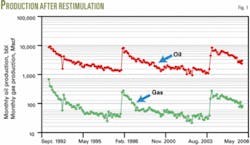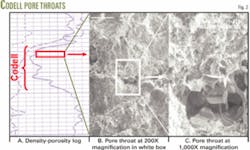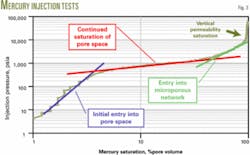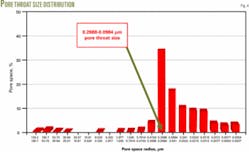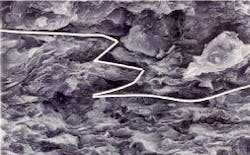Theodore A. Pagano - Kerr-McGee Corp.,Evans, Colo..
The Codell formation in Colorado is an example of a formation whose rock properties and deliverability mechanism allow for successful restimulation.
Many references provide information on stimulating wells with fracturing techniques. Several of these references address the theoretical principles for obtaining a positive response from restimulation, including fracture reorientation and lengthening, and effects of principle stresses
While some data may support these considerations, few references discuss the reservoir rock and fluid properties of reservoirs in which field-wide blanket restimulation works.
The Codell and the Barnett shale in Texas are two such examples, and this article focuses on the rock properties and deliverability mechanism of the Codell in Colorado’s Wattenberg natural gas field.
This review will clarify why restimulation works on the Codell and demonstrates the underlying fundamentals that have led to a successful restimulation program.
The oil and gas industry can use this information to recognize and identify analogous applications. For instance, the Barnett shale is an example of a formation that responds to blanket restimulation. Its rock attributes and reservoir circumstances parallel those of the Codell.
Restimulation
The industry’s success rate for tight-reservoir restimulation is less than 1 in 10, in large part due to an incomplete understanding of why restimulation works and where it is applicable. Unquestionably, a reservoir will respond to restimulation when:
A careful review of potential restimulation candidates can provide economically successful investments.
The Codell formation in the greater Wattenberg field, however, responds unconditionally to blanket restimulation despite a failure to fall into any of the previous categories listed.
A thorough study of the producing nature of the Codell formation reveals that overpressured shales will respond to restimulation.
Codell formation
In 1997, an operator performed the first restimulation of a Codell well in the Wattenberg gas field. Since then, operators have done more than 3,000 restimulations (refracs) in the Codell formation in the Wattenberg field, including successful tri-stimulations, which is a third fracture treatment in the same well (Fig. 1). The first quad-stimulation is on the horizon.
Long-held reasons for success from restimulation in the Wattenberg have included fracture reorientation and lengthening. But an understanding of reservoir deliverability mechanisms, however, sheds new light on the positive restimulation results in the Codell.
Case studies from Kerr-McGee Corp. that include comprehensive reservoir, core, and fluid analysis provide new answers as to why restimulation works in the Codell.
Traditional models in the Denver-Julesburg (DJ) basin quantify the Codell as a tight sandstone, but a closer review reveals that the Codell is better described as a shaly siltstone with minimal to no effective porosity.
In fact, the Codell contains 20-40% mixed layer clays, both deposited and authigenic. Fig. 2 shows an interval in the Codell that has the highest density-porosity log response and best net pay. But even under this high magnification, traditional sand grains and effective porosity are not observed. Rather, the figure shows a shaly collection of mixed layer clays, not just coating, but thoroughly a part of the Codell matrix.
The few visible pore throats are lined with chlorite, a highly mobile and unstable clay type (Fig. 2c) and are not effectively connected to other pores. The Codell has poor visual reservoir quality; however, closer examination can discern a unique attribute.
Geologists observing and describing the Codell core sample noticed a unique secondary pseudomicroporosity created by the space between the mixed layer clay particulates. While the core had no observable conventional effective porosity, it had an observable pseudomicroporosity within the silty clay matrix.
This pseudomicroporosity is a secondary porosity network, not the same as, but analogous in fluid deliverability to natural fractures; hence the pseudo prefix.
A mercury injection test into a Codell core plug corroborated this visual observation. The test demonstrated a dual-porosity response despite no observable effective porosity and no visible natural fractures (Fig. 3).
The Codell’s visually observable pseudomicroporosity opened as pressure increased and closed as pressure decreased.
In 2004, Kerr-McGee initiated a field-wide fluid injection and leak-off analysis. In more than 60 wells, the Codell showed a pressure-dependant leak-off, which is a way of saying that the Codell has a dual-porosity network that opens as pressure increases and closes as pressure decreases. These results corroborated the visually observed pseudomicroporosity and the response in the mercury injection test.
Fig. 4 illustrates the distribution of the Codell’s pore-throat size. More than 80% of the porosity has pore throats smaller than 0.25 μm in diameter, which by all standards, is a microsized pore throat. Traditional sandstone pore throats are larger than 5 μm, while siltstone pore throats are larger than 2 μm.
The Codell’s core description, its pore-throat size, and its dynamic, pressure-dependant microporosity is more analogous to a shale rather than to a sandstone or siltstone.
Fig. 5 shows an assumed migration path and deliverability mechanism for hydrocarbon through the Graneros shale; one of the DJ basin’s source shales.1
The assumed migration path through the Graneros clay particulates is analogous to the pseudomicroporosity of the Codell. In a similar fashion, the formation must store the hydrocarbon and allow it to travel through the pseudomicroporosity.
The space between the clay particulates, which is accentuated by the presence of silt, provides the porosity responsible for hydrocarbon storage and hydrocarbon deliverability.
Fig. 6 is a type curve from a density log illustrating how a shale responds to overburden as depth increases. The overburden force, which is the weight of the rock above the subject interval, compresses the shale as depth increases; hence the gradual increase in the shale-density gradient.
When the shale contains pore fluids in an overpressured environment, the shale will balloon, reversing the density response. One can observe this phenomenon more in the case when dispersed clay or shale is disseminated throughout existing pore space than in interbedded shale.
Wildcat drillers use this pressure-dependant phenomenon to watch for overpressured intervals. By running a measure-while-drilling density tool, they will carefully monitor the shale density gradient.
If they observe a reversal in this gradient, they can anticipate the possibility of an overpressured sandstone before it appears. This allows them to mud up accordingly to prevent the possibility of a blowout.
The Codell formation is in an overpressured, hydrocarbon source interval with an average pore pressure gradient of more than 0.62 psi/ft. Therefore, the pseudomicroporosity of the Codell is ballooned and serves as the effective porosity network responsible for the deliverability of the Codell with its 0.002-0.05 md permeability.
Similar to a naturally fractured reservoir, the pseudo microporous reservoir’s deliverability depends on the number of open and effective microporosity features that network through the reservoir matrix. Pore pressure and pore fluids propagate the microporosity and influence hydrocarbon movement from the reservoir to the wellbore.
About 80% of Codell’s effective porosity has pore throats less than 0.25 μm in diameter; which are too small for propagating fractures with proppants. Therefore, the preservation of Codell’s microporosity solely depends on the presence and pressure of pore fluids. The microporosity will close whenever the propagating pore fluids are removed from the microporosity network faster than the matrix can recharge them.
Even if operators take prudent precautions to reduce the withdrawal rate so as to allow adequate time for microporosity recharging, reservoir depletion may lead to the unavoidable consequence of reduced deliverability. This is the fundamental reason that restimulation can succeed in overpressured shale reservoirs.
In the case of Codell, the appearance of retrograde condensate, condensate, and dead oil all contribute to relative permeability changes that deteriorate reservoir deliverability over time, especially because of the small pore throats. Yet, the dynamic change in microporosity with pressure is the underlying reason that hydrocarbon flows and restimulation works in the Codell.
The greatest pressure drawdown and pressure depletion is near the wellbore, or more appropriately, near the propagated fracture length. This in turn causes the greatest amount of microporosity closure.
A refrac reengages the closed and potentially damaged microporosity, creating a renewed productivity index similar to the initial well index despite the lower observed reservoir pressure.
A careful observation of the Codell’s GOR and the character of its produced fluids support the idea that the lower observed pressures confirm that the refrac does not engage a new, virgin reservoir.
The refract reengages the previously drained reservoir by renewing the microporosity deliverability. Over time the Codell’s microporosity will close, which enables the operator to successfully reengage the reservoir a third time; hence the success of Kerr-McGee’s tri-stimulation program.
Other applications
The Barnett shale is an overpressured source interval with permeability ranging from 0.001 to 0.01 md. As mentioned previously, the Barnett shale responds analogous to the Codell during stimulation and restimulation. The likely reason for the response is its analogous rock properties and pressure circumstance to the Codell that create a dynamic porosity and deliverability.
Fig. 7 shows the shale reservoir basins in the US that may also hold a possibility for successful restimulation because of the dynamic deliverability of overpressured shale.
References
1. Pietraszek-Mattner, S.R., Source rock analysis of the Graneros shale, Denver Basin, Colorado, related to depositional environment, generative potential and primary migration, PhD thesis, Colorado School of Mines, 1995.
2. Schlumberger Log Interpretation Principles-Applications, 1989.
3. Goldfaden, B., Capturing the Huge US Shale Gas Prize, Inside Schlumberger, 2005.
The author
Theodore A. Pagano ([email protected]) is a senior production engineering specialist for Kerr-McGee Corp. in Evans, Colo. He is a professional geologist and engineer with extensive experience in the US Midcontinent and Rocky Mountain regions. Pagano holds a BS in geological sciences from the University of Notre Dame and an ME in petroleum engineering from the Colorado School of Mines.

